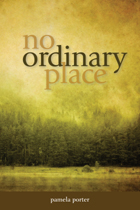Reviews
Poetry Review by Heather Jessup
Pamela Porter, No Ordinary Place (Vancouver: Ronsdale, 2012). Paperbound, 103 pp., $15.95.
In Pamela Porter’s fourth collection of poetry, No Ordinary Place, enclosures, gardens, paths, homes, barns, orchards, and pastures—places generally thought of as ordinary or, at times, empty or abandoned— are enriched. Our perception of place is heightened through Porter’s language, so that the overlooked is made visible. In Porter’s poems life is never limited to the human. Horses, hummingbirds, the branches of apple trees, and many nights’ moons are given the grace of daughters. In Virginia Woolf’s Between the Acts, there is a description of a barn: “The barn was empty. Mice slid in and out of holes or stood upright, nibbling. Swallows were busy with straw in pockets of earth in the rafters. Countless beetles and insects of various sorts burrowed in the dry wood…. All these eyes, expanding and narrowing, some adapted to light, others to darkness, looked from different angles and edges.” It is of Woolf’s barn that Porter’s poetry most reminds me. A place is first described as “empty” but suddenly, with attention, the emptiness is filled with eyes. Faces are revealed where we thought none existed. The ordinary is surprisingly populated with the burrowed unexpected. Yet the claim to “emptiness” is never extracted or revised. Woolf’s barn remains both empty and full. Porter’s poetry traces the brink between fullness and emptiness; between lives we expect and mysteries we cannot attain.
Christian mysticism inflects Porter’s animistic exploration of the living world. In “Astonished Heart,” the Gospel becomes “the gospel according to trees,” in “Seeking and Finding” birdsong becomes “A Tallis choir,” and in “Little Parable,” “God sweeps the floors of your house / and gathers up the dust / which small birds carry to their nests.” In “Naming” the poem echoes Adam’s naming of the animals in Genesis, but with revisions. Instead of the taxonomies of the Old Testament, names are coaxed through collaboration: “And what if I name you clear brook / murmuring over stones, / and you name me little cloud / shy behind the moon?” The speaker suggests that silence, too, ought to be made part of naming, the ineffable taken into account: “Then let us drink tea in silence / while small birds lift into the sky, / holding in their beaks / the words we don’t need to say.” Rather than a monotheistic God beyond this world, it is the birds, these “little feathered gods” who, at the end of the poem’s creation, “proclaim it good.”
Despite No Ordinary Place being Porter’s fourth collection, there were times in the book when I desired a rigour and specificity from her language that felt lacking in the poems’ traversal of ephemeral themes such as birth, heaven, death, grief, and the afterlife. As the epigraph of the book indicates, the mystery of what happens before our births and after our deaths is central to the collection: “from no ordinary place / do we come, and there / will we find each other again.” Yet, it is my hunch that the mysteries of our existence are oftentimes most clearly revealed in attending to the simple tasks and objects before us in the physical world. In Pablo Neruda’s Elemental Odes, for instance, the poet observes “the resurrection of each day” that occurs when a rider brings a bicycle whirring back to life with his pedalling. Or morality is contemplated by wondering about the relationship the poet has with his suit. It is in tomatoes, seaweeds, and socks that Neruda finds the spiritual. Salt becomes, quite believably, a “translucent cathedral.” Yet there is something about No Ordinary Place that does not touch down on earth’s earthiness enough. The poems remain abstract with lines such as “Another word for daughter is remember” and “Another word for mother is silence”; or “My cities of memory” and “Mysterious astronomy of the rose” and “Compass / of the universe”—images that feel beautiful, but whose meaning and metaphor I find difficult to access. Moons and birds are repeated throughout the collection, nearly to exhaustion. Daughters and mothers inhabit trees and night skies. But why? What are these repetitions meant to teach me? At times I felt as though I was attending a church service in Latin: the intonation lulled me, but I could not understand what rites the priestess performed.
This occasional lack of the elemental in No Ordinary Place was surprising given the vivid particularities found in Porter’s previous collection, Cathedral. In Cathedral, spiritual questions are asked and prayers are given throughout the poems, but the details of Ghana and Buenos Aires ground the poems’ spiritual ponderings in the concrete details of laundry being pounded with stones, pepper plants blossoming, kerosene lamps, mango pits, and seamstress’s huts. Travel, in Porter’s writing, more aptly triggers access to the extraordinary and otherworldly, to the godly present in the secular.
One of the most moving poems in No Ordinary Place is from a series in the book about an aging father. In “Holding On,” the narrator witnesses her seventy-one year-old father in the branches of an apple tree, pointing “his clippers at the sky/ as if he could snip a piece of that blue cloth, / carry it into the house / and spread it over his bed.” Fearing the father’s precarious balance, the daughter proclaims, “I want to be gravity, pull my father / back to earth.” It is the care in these poems toward the living that I will most remember, be it toward hummingbird or human.
—Heather Jessup









